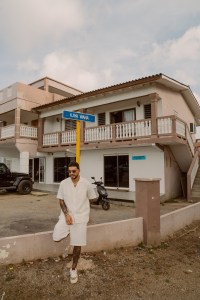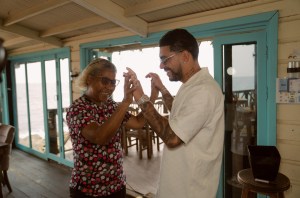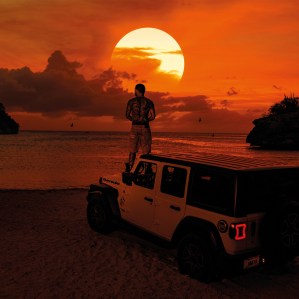
Ryan Castro, in front of his former apartment in Curaçao, photographed on May 28 by El Skinny.
El Skinny
On a humid and cloudy day in Curaçao, with its endless ocean views and pastel colonial buildings lining the streets, Colombian star RyanCastro is eager to talk about the roots that shaped him as an artist and as a person. This isn’t the all-too-familiar story of a global music sensation, but more an intimate look at the places, people, and moments that inspired his second album, Sendé (out May 29), an ambitious love letter to the Caribbean.
Here, on the narrow streets of Jan Thiel, inside a Jeep Wrangler, Castro retraces the steps he walked years ago as a teenager juggling everyday jobs while writing songs and dreaming big. On this occasion, Billboard Español had the privilege of joining him on an intimate experience around the island.
“It was while I was living on the island that I blew up in Colombia,” the artist recalls. “I think it was the right time to share that with everyone and let them know about my life here and my cultural influences too, because I love dancehall. A lot of the things Castro does are deeply connected to this island.”
It was during those formative years on the island — where he spent a couple seasons because his mother lives here — that he refined his sound and began gaining recognition back in Medellín, ultimately laying the groundwork for the artist he is today.
Hours later, we visit the nursing home where his mother, a nurse, works to this day — a place where Castro did shifts as a young man — while secretly ditching work and chasing his dreams. As we step inside, Castro reflects on the sacrifices his mother has made and how their journey together has shaped not only his life but also the personal story he shares on Sendé.
Zipping across the island’s sunlit landscapes, he shares laughs with old friends and waves to delighted fans, who call out to him for selfies as he explores the streets of his second home.
With his sophomore album, Castro, 31, moves away from “El Cantante del Ghetto” and fully embraces a more vulnerable, romantic side of himself. A love letter to Curaçao — the LP not only reflects a place where he lived and worked hard but also one where he unearthed a deeply personal part of his identity that had remained semi-hidden.
“Sendé is a very personal project that reflects everything I lived and learned in Curaçao,” Castro shares. “It’s full of emotion, Caribbean influences, and that dancehall vibe that’s always been part of my style.
In this album, Castro masters the fusion of genres like dancehall, kizomba, afrobeat and reggae, all infused with his signature urban style. He also collaborated with an impressive lineup of international artists, including Shaggy (“Exclusiva”), Peso Pluma (“Un Trío”), Manuel Turizo (“Menos el Cora”), and Curaçao’s renowned local singer, Dongo, on the song “Sanka”, a title that means “unfortunately” in Papiamento, a Creole language based principally on Spanish and Portuguese, spoken and written in the islands of Curaçao, Aruba and Bonaire in the Netherlands Antilles.
But beyond the big names and captivating rhythms, the album is an invitation to explore his story and connect with the cultural roots that have profoundly shaped his artistic vision. “The title [Sendé] comes from Papiamento and means feeling good, positive vibes, and that’s exactly what I want to put out there,” he adds.
In an exclusive interview with Billboard Español, Ryan Castro shares the moments that shaped his life, his deep connection to Curaçao, and how Sendé became his most personal project to date.

Ryan Castro, in front of his former apartment in Curaçao, photographed on May 28 by El Skinny.
El Skinny
Curaçao holds a special place in your life. How do you feel being back now on the island?
I came to visit my family. My mom and siblings live here. Right now, we’re driving through a neighborhood called Jan Thiel. There are really beautiful houses here where wealthy people live, and a lot of Dutch folks too. We’re heading to a restaurant called Perla del Mar. I like going there because I used to work as a waiter and did a lot of things in the kitchen as well. Whenever I come to Curaçao, I bring my friends, family, or partner. I love reminiscing about those moments and sharing them with people who are super proud and happy to see me. Today, we’re on our way to grab lunch, eat some fish, and recharge.
From El Cantante del Ghetto, inspired by your upbringing in Medellín, Colombia, to Sendé, a project rooted in Curaçao — how do you feel about sharing this part of your story and reflecting on those key moments in your life?
I feel really happy because I think my fans were missing this side of me. I’ve shared a lot about my story in Medellín — life in the ghetto, singing on buses, where I came from, which is so special. But I hadn’t talked much about this side, which is also something very emotional for me. It was while I was living on the island that I blew up in Colombia. I think this was the right moment to tell them about it and let them know what life was like for me here, as well as my cultural influences, because I love dancehall. The words I often use, like “awoo,” are for them to understand where all of that comes from. A lot of the things Ryan Castro does are closely connected to this island.
We’ve noticed that you also speak Papiamento and use phrases from this language in your music. What do these expressions mean to you?
“Awoo” comes from the local language here, Papiamento. It’s a very street-style word. People here use “awoo” like “hey” or as a greeting. In Colombia, we use words like “oe” or “nea.” “Awoo” isn’t a formal word for conversation, but when I got here, I heard it all the time.
I use it on my social media, and the fans embraced it — they even call out “awoo, awoo” now to me. So, I started working with the word. This album, called Sendé — another word from Curaçao — means “lit” or “fire.” But here, people use it to mean that everything’s good. You can say “awoo” to someone, and they’ll reply “sendé.” On the streets, it’s used to say we’re feeling great, hyped, happy, partying, or full of energy. It’s a very lively word.

Ryan Castro, dancing with a cook at Perla del Mar, the restaurant where he once worked as a waiter, photographed on May 28 by El Skinny.
El Skinny
When did you move to Curaçao? You mentioned that your mom has been living on the island for quite some time.
My mom has been living here since I was a kid. Basically, I was born, and about a year later, my mom came here looking for a better future for herself and for me as well. I came here when I was around 13 or 14 years old. My mom’s intention was for me to stay and live here because she was already settled — she had her husband and everything in place. But I was too young, and I couldn’t handle it. I was in school, and I ended up going back to Colombia.
When I finished school, around 16 or 17 in Medellín, I sang on buses and hustled to make it. Once I felt more prepared, I told my mom I was ready to come back. I moved to Curaçao when I was about 20 years old. I came to spend time with her, to look for a new future in music, work, and my dreams.
In Sendé, you worked with genres like dancehall, Afrobeat and some reggae. How has Curaçao’s musical culture influenced your creative process for this album?
Here in Curaçao, there’s a lot of amazing music — party vibes and romantic tunes, at least around here. I learned a lot about kizomba, reggae, and carnival music. I think it’s super cool because during the carnivals, you hear a very unique style of music called tambú, which is a really intense drum-based sound. At that time, I was already doing dancehall, rap, and reggae before coming here. But I’d hear those rhythms and think, “How would my voice sound on that?” Or, “I want to make a song and experiment with those flows.”

Ryan Castro, en el restaurante Perla del Mar, donde fue mesero, fotografiado el 28 de mayo por El Skinny.
El Skinny
I would go to recording studios, and there were Dutch, Jamaican or Curaçaoan people — I didn’t even know how to communicate. So that pushed me too. I’d say, “Bro, I need to learn their language to understand their music and culture.” I had to learn the language, and I did it through music, by listening to songs from here and picking up the street language.
Culturally, I absorbed so much — the rhythms, the language, the way people talk, the carnivals, the parties, the music they play at the beach and in the restaurants — I loved it all. That inspired me a lot while making this album, and I even brought my creative team here so they could experience the music. I took everyone who collaborated with me on the album — producers, artists — to the boats and boat parties, the restaurant, the ocean, so they could feel the vibe of the island, and we ended up with an incredible album.
You collaborated with artists like Peso Pluma, Shaggy, Sean Paul and Manuel Turizo. Tell us, how do you decide who to collaborate with?
Honestly, I’m a bit particular about that. I like collaborating with artists I vibe with, where there’s good energy between us. Of course, this is also a business, and it’s great to work with someone who’s super popular, but honestly, that’s the least important thing to me. For me, it’s key that there’s chemistry and mutual respect. The song belongs to both of us, so we both need to be willing to put in the work — whether it’s media, videos, content, performing it live, and everything else that comes with it.
I’ve had cases where there are artists I admire a lot and have always wanted to record with, but when I meet them, I don’t vibe with them. So, I’d rather not collaborate to keep admiring them and not lose the respect I have for them. For me, making a song is an intimate and special moment between artists, and both of us need to be fully committed for the result to be something truly beautiful.
What do you hope listeners take away when they hear the album?
I hope it makes them want to hit the beach and visit Curaçao. I want them to connect more with me — my style, my flow, my roots, who I am. The idea behind the album is also to put Curaçao a little more on the map, in people’s eyes and ears. I even included an artist from here, named Dongo, on the song “Sanka.” He might not be very well-known outside the island, but here, he’s highly respected. For me, the album is also a way to give back to Curaçao for all the motivation and inspiration it has given me.
Stream Ryan Castro’s Sendé below.

Ryan Castro ‘SENDE’
Courtesy Photo
Note: The trip to report this story in Curaçao was sponsored by Ryan Castro’s team, who provided funding for airfare and accommodations.